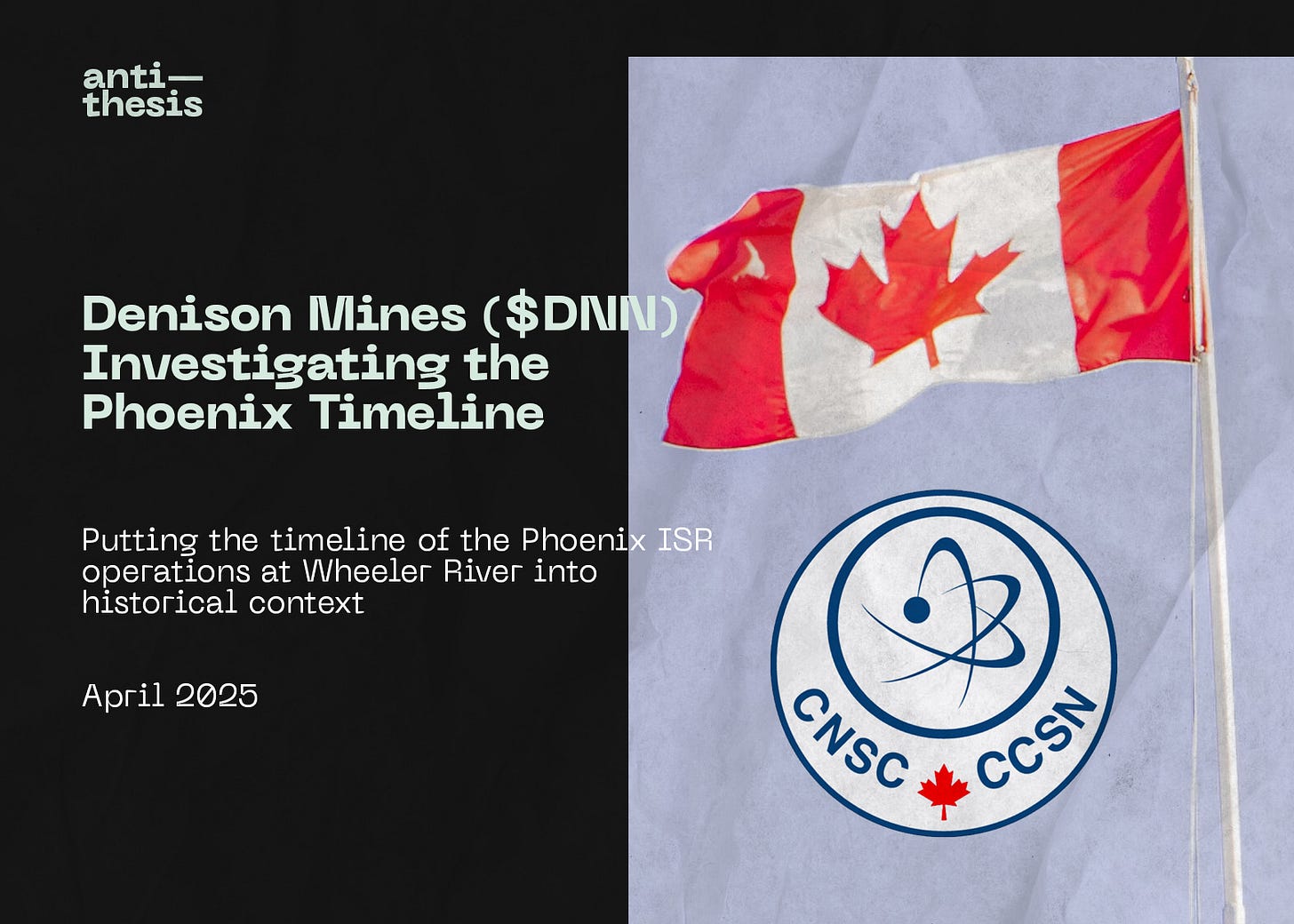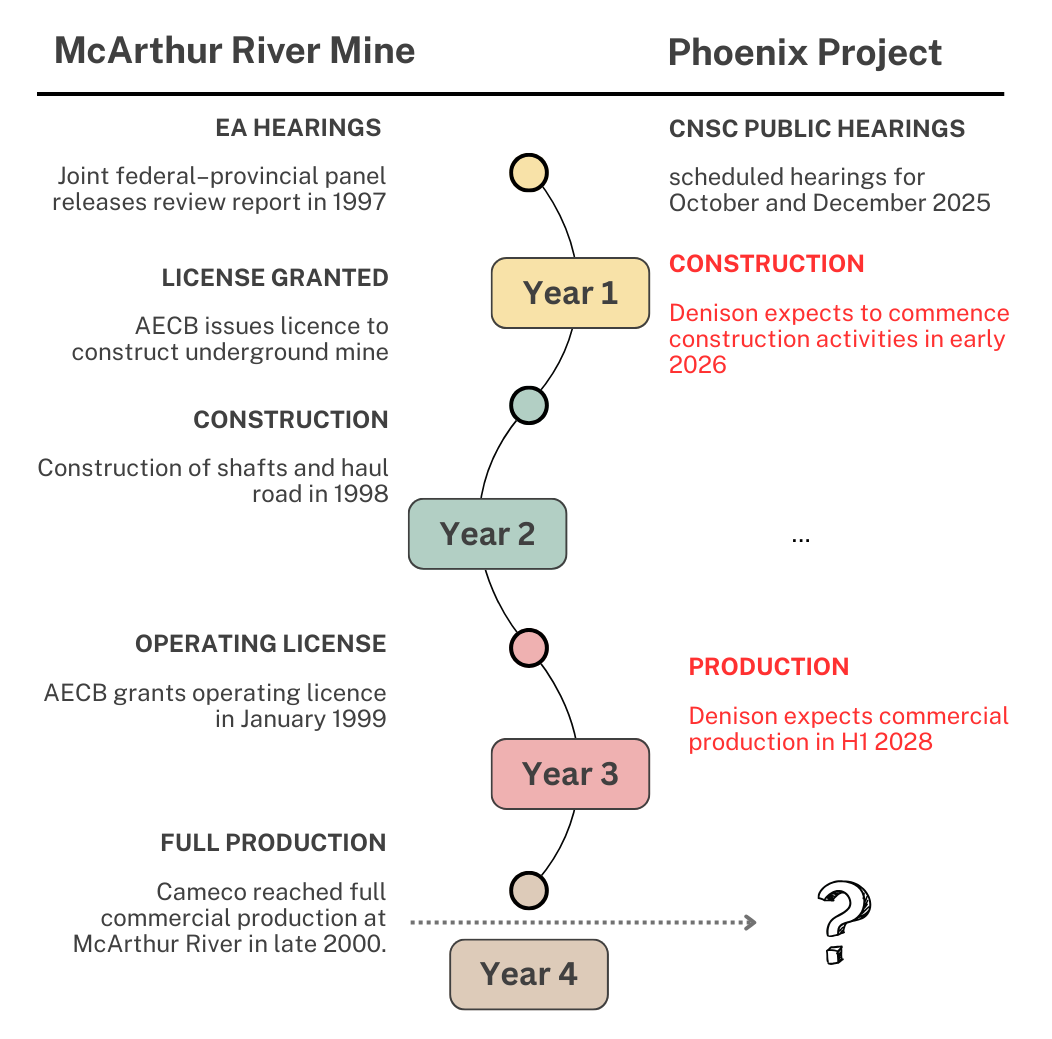Denison Mines: Investigating the Phoenix Timeline
Putting the timeline of the Phoenix ISR operations at Wheeler River into historical context reveals that Denison's assumptions might be a bit aggressive. Find out why...
The Canadian uranium mining sector operates under strict regulatory oversight, with the Canadian Nuclear Safety Commission (“CNSC”) playing an important role in the approval process.
Denison Mines ($DNN) has recently received confirmation of their CNSC public hearing schedule for the Wheeler River Uranium Project, specifically for the Phoenix In-Situ Recovery (ISR) operation. This follows the CNSC’s approval of Denison’s Environmental Impact Statement (“EIS”), which was granted in December 2024. The CNSC is now preparing the Environmental Assessment (EA) Report, which will be made available for review by Indigenous Nations and communities and the public before the hearing.
The CNSC has scheduled the public hearings in two parts:
Part 1: October 8, 2025
Part 2: December 8-12, 2025
Interestingly, NexGen Energy, which received Provincial EA approval already in November 2023, will have its public hearings later than Denison (November 19, 2025, and February 9-13, 2026). One wonders what NexGen did in the meantime.
Nonetheless, these hearings represent the final step in the federal approval process for both the Environmental Impact Assessment and the License to Prepare and Construct a Uranium Mine and Mill. Denison expects to commence site preparation and construction activities 1-3 months later, in early 2026, and to commence commercial production in H1 2028.
It is worth noting, however, that previous timelines provided by Denison had the commercial production target date set to H2 2027. Without much commentary, it has been delayed by half a year. Many Supply/Demand models have included Phoenix’s output for 2028 onwards. This means that only 2 to 2,5 years are expected to pass between the CNSC Hearings and the start of commercial production, and Denison’s projections are widely accepted. Let’s use the McArthur River mine for reference to find out whether these projections are realistic.
The McArthur River Timeline
The McArthur River project (Cameco) followed a similar process in the late 1990s. A joint federal–provincial panel reviewed the development and released its report in early 1997. After that EA, provincial and federal governments approved the project in 1997, and the AECB (CNSC’s predecessor) issued a licence to construct the underground mine that year. Construction of shafts and the haul road took place in 1997–99, and the mine achieved full production once an AECB operating licence was granted in January 1999. The mine then reached full capacity by late 2000.
For Cameco, a well-established producer, it took around 3,5 years to go from public hearing to full production. And the McArthur River mine is a classic Raiseboring operation, unlike Phoenix, where Denison will be the first company to utilize in-situ recovery (ISR) for uranium mining on a commercial scale. This should urge some caution regarding their timelines.
Conclusion
Taking Cameco’s McArthur River timeline for reference suggests it will take 3,5 years (as opposed to 2,5 years) for Denison to bring Phoenix to full production. That would mean that full production might occur in H2 2029.
If we add another 6 months for difficulties related to ISR mining, it’s already 2030. That would be the worst-case scenario, however. I think Fall 2029 is realistic. Notably, I do not think NexGen’s Rook I will be in production at that time. ;-)
Despite the suboptimal outlook regarding the commencement of production at Phoenix, I still believe Denison is currently trading at a discount relative to the value of Phoenix and its other assets. It is a core holding of Anti—thesis.
Thank you for reading. If you found this article helpful, please consider subscribing. You will receive regular, high-quality updates on different stocks and investment ideas in the natural resource sector. And it’s FREE.



